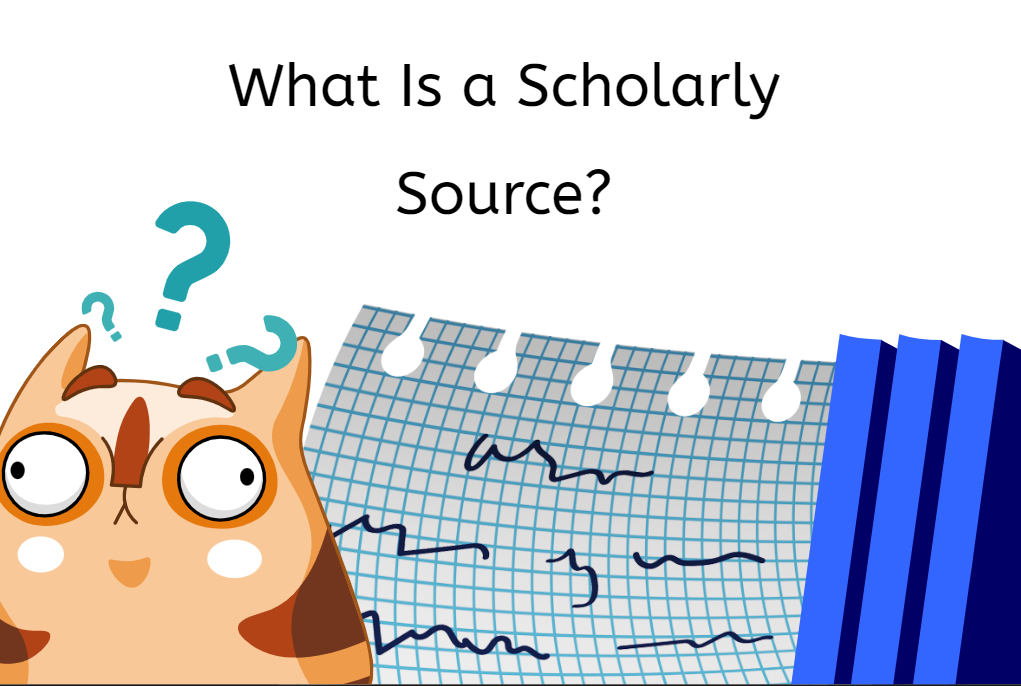
While working on your research paper, you must have come across the term “Scholarly Sources” several times. So you might be wondering ‘What is a scholarly source?’ Scholarly sources are the most widely used reference sources in academic research and writing. And if you are working on your own piece of academic writing, you should know how to read and refer to scholarly sources.
In this blog, we will tell you what a scholarly source is, its structure and more.
Table of Contents
What is a Scholarly Source?
Scholarly sources (also referred to as academic or peer-reviewed) are written by experts in a particular field or discipline of study and serve to keep others interested in the topic up-to-date on the latest research, findings, and news.
It has many different features as compared to a popular source, including:
- Scholarly sources are usually authored by academics and researchers with advanced degrees that reflect their expertise in the field.
- They are specifically written for a selective audience that includes academics, researchers and professional colleagues.
- A university press, professional society, or recognized scholarly publisher generally undertakes to publish only scholarly resources.
- Because scholarly resources are curated for a special audience, they are written in a language, style, and format that their audience would easily grasp. However, it is difficult for someone outside of this audience to understand the actual meaning itself.
When we use the term scholarly sources, we are primarily referring to publications that include scholarly, peer-reviewed journals. However, commonly recognized textbooks, data sets, and electronic and printed instructions fall into the same category of professional resources. You can easily reference and obtain essential information for your research from these trusted sources.
Remember not to confuse scholarly articles with other academic publications because many young researchers confuse scholarly articles with other academic publications.
Why use scholarly sources?
Using scholarly sources will add weight and credibility to your research papers. Many professors expect students to use scholarly sources when writing a college research paper. Thus, it is an expected attribute of any academic or scientific research work. However, Scholarly articles are the best resources to use in your bibliography for several reasons:
- The standardized structure allows you to quickly find the data you need.
- Strict quality requirements combined with a peer review process make them a reliable source of information.
- The relatively small volume of the text allows researchers to produce many scholarly articles in a short time. Other experts who follow this genre of research are thus constantly updated.
Where to Find Scholarly Sources?
When working on a research project, you must have easy access to reliable, trustworthy and up-to-date information in your chosen research area. Scholarly sources are the best references that you can best use to make your arguments and claims against your research question.
Scholarly resources are available in both print and digital formats. In the library, we subscribe to digital formats through various databases. You can either search a library or search a specific database. The following guides are also useful for finding scholarly resources:
- Resource Types: Provides links to key databases for different types of resources.
- Choosing Databases: Answers questions related to choosing the right database for your needs.
- Search Strategies: Identifies key strategies you can use when searching for professional resources.
You can always search for scholarly resources on Google Scholar and Microsoft Academic. These are free search engines but they have their pros and cons. In addition to the ease of use of these academic search engines, it can sometimes be very difficult to determine whether the results obtained are trustworthy. In addition, quality changes are evident in these search engines.
Purpose of a scholarly source
The purpose of a scholarly source is to:
- Provide credible information about the research idea.
- Spread knowledge and awareness across a specific discipline.
- Review or re-evaluate currently available forms of research work.
- Provide in-depth insight into the specific topic on which the research is based.
How to determine if a Source is Scholarly?
Once you understand and know the purpose of a scholarly source, it will be easier for you to discover and identify it. Following are the attributes to look for when trying to identify a scholarly source:
Authorship
The presence of an author’s credentials is the first reflection of a scholarly source. Therefore, you need to verify whether the credentials are appropriate or not. Take this as a pro tip; always try to do a credential search in google scholar. This will help you determine if the author is a real expert or just a namesake.
Publisher
You need to check if the journal is peer-reviewed or not. Always try to observe that the publisher of the journal must be a university publisher, a professional organization or a reputable commercial publishing brand. In addition, you should check the author’s guidelines for submitting manuscripts. The presence of such an option provides some degree of confirmation that the journal is sufficiently trustworthy.
Audience
When browsing a scholarly source, you will find that it has been written for a specific group of readers, including researchers, academics, and subject matter experts. In general, a technical article presents technical terminology rather than formal. In addition, scholarly sources are often created for an audience that already has knowledge of the subject.
Review and Citation of Author’s Work
After an author’s work has been published, another researcher often cites or uses previous research in the discipline to apply their findings. In addition, scholarly books are often peer-reviewed after publication, and that too in an in-depth and thorough manner.
As a researcher, you must look for book reviews if you are using the book as a scholarly source. To verify you can use Google Scholar. In Google Scholar, you should look for citation statistics. This allows you to view the entire citation history since it was published.
Structure of the Publication and Content
Reputable and trusted journals always follow a certain structure while publishing. Includes abstracts, literature, methods, results and conclusions. Therefore, you must check whether the source you are validating for inclusion in the research contains these parameters or not. In addition, you should ensure the presence of a list of references.

Hire Expert Writers at Affordable Price
- Get Guaranteed Quality Assignment Help
- On-Time Delivery
- Professional Academic Writer
- Best Price Guarantee
Anatomy of a Scholarly Article
Whether you are using a library database or a search engine to find scholarly sources, once the list of sources is visible on the screen, there are several key points that you can use to determine whether a source is scholarly. Below, we’ve outlined the common anatomy of a scholarly article through a few key points:
Title
Not always, but usually and very often, the title of a scholarly article is a short and precise summary of the content of the article. The title can also be considered a research question. In general, the title contains technical terms related to the mentioned research.
Authors
One of the main reasons for the high credibility of scholarly articles is the high degree of transparency they create. This transparency is always shown by indicating the names of the authors and their credentials (in the case of multiple authors).
Abstract
Generally written in 300-400 words, an abstract is like a summary of a research topic. The abstract is the part that allows readers to decide whether the article is a relevant research topic or not.
Introduction
The introduction provides information about the research question and the problem the authors are trying to solve.
Publication
All information about the publication can be found in the footer of the first page or sometimes in the header. It usually contains information regarding the journal title, issue number, year, and page numbers.
Charts, Graphs, and Equations
Statistical data related to research work is often presented in scholarly articles in the form of tables, graphs and equations.
Article Text or Body
The main discussions, including methods and methodology describing and analyzing the scope of the research, are presented in sections and subsections. This is usually referred to as the “body” of a scholarly article.
Conclusion
The section where the authors summarize their work and present the outputs or findings in the results is called the concluding section.
References
An article is marked as scholarly if it contains substantial research and information about related works in the current discipline. Then, in this section, all related and reference resources are presented in list form. Generally, a scholarly article contains a long list of reference sources.
and this was it folks. We hope this guide on Using Scholarly Articles as Sources helped you with your academic paper.
Cite a Scholarly Source:
The whole idea behind finding a relevant scientific source for a research topic is to use its findings and interpret its results in your research paper. You can support your arguments for results and outcomes through these scholarly sources, provided these sources have appropriate evidence to support the research topic. Be careful in selecting the most relevant and applicable evidence for your research topic.









